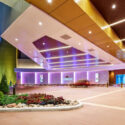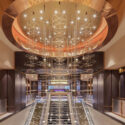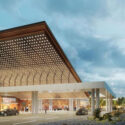Virtually every American industry is confronting harsh economic realities this year. Unable to easily circumvent the fiscal damage, smart gaming industry executives have developed a new operating mentality. Rather than construct or expand existing facilities, many are opting to renovate. They believe that despite a shortfall in funding for major overhauls, cosmetic changes that increase their venues’ versatility will still appeal to customers.
Do Different Regions Face Different Problems?
The American Gaming Association’s 2009 “State of the States Survey of Casino Entertainment” reports revenue losses in five of the 12 commercial casino states in 2008. These statistics are widespread because one corporation may own multiple locations in several states.
What affects one jurisdiction may affect the profitability and available capital of the entire chain. For example,Las Vegas Sands opened its new Sands Bethlehem casino in Pennsylvania on May 22. However, the resort’s plans for a full-scale hotel and retail plans are on hold because LVS has confronted economic issues at its Nevada headquarters. Many other large and smaller corporations have had similar scenarios across the U.S.
Following the housing and banking crises, coupled with travel costs, Las Vegas and other Nevada cities have suffered severe repercussions. Unlike other jurisdictions built on diverse businesses, Nevada depends on a vital gaming industry.
Kimberly Daoust, principal of the Tandem interior design firm in Las Vegas, believes the reality is just starting to hit home.
“Last year we still could cross our fingers and hope,” she says. “This year, 2009, is when reality set in, but we can still only shake our heads and sigh. As casino and hospitality interior designers, the federal Stimulus Package was a box we were expecting, but was delivered to the wrong address. No credit means no projects. It’s as simple as that.”
The Effect On Interior Designers
Sagging customer budgets have forced many interior design companies to trim their own expenses and conserve cash as they attempt to meet their customers’ expectations.
One downside has been the resulting price wars.
William Langmade, president of Purchasing Management Internationalof Dallas, says, “The hardest thing to control is the sudden drop in our competitors’ fees. Many will drop prices in half for expedient cash flow, resulting in not only a huge drop in business, but also a huge reduction in fees for the business still there.”
Daoust states operators are running the gamut with their renovations, and unfortunately, interior designers do not always receive a clear direction.
“There are property owners who see this as the ideal time to renovate and expand, knowing that materials and services are available for less. There are owners who are visionaries and optimists. They believe their properties should be in tip top shape and ready when conditions improve. Other owners aim to reinvent and rebrand themselves-a metamorphosis from their dark, smoke-filled casino spaces-to a level of hip and cool,” Daoust says.
She states that some operators have chosen to purchase materials themselves to cut down on contractor mark-ups. They have used in-house millwork and framing rather than employing outside subcontractors. These operators bought used hotel furniture that may be refurbished and reupholstered. Although using substitutes, quality renovations can get the same fresh look as those new designs.
Little Things Make Space Flexible
Despite the terrible economy, casino operators cannot afford to let their properties deteriorate. Executives are taking a second look at their projects.
Paul Heretakis, vice president of Westar Architects in Las Vegas, says casino clients have asked his firm to consolidate and maximize the use of each space they design. These reduced expenditures affect all areas across the board, including restaurants, retail and spas.
Heretakis says, “Clients are making minor remodels or remediation as they take more conservative approaches to spending money. Minor renovations can include restaurants, bars and casino space as long as the major items stay in the same place. New finishes, service and a brand can make a big impact.”
For Terry Dougall, owner of Dougall Design in Pasadena, California, renovations may not be difficult if planned around the full range of potential events. He states that surveillance cameras and lighting present the greatest challenges, and should be easily portable or provide redundancy for a quick layout change.
Even the most superficial upgrade can improve the aesthetics. Dougall says, “Nothing changes a casino faster than the carpet. Next is the decorative lighting… chandeliers in particular. Too many casinos are dark and foreboding, or just boring. Wall covering is the third primary refresher because it adds life to a space. All three may be done quickly and inexpensively.”
Daoust agrees that carpet designs can clearly date a casino. She says, “Older carpet designs have smaller repeats; the more modern carpets have larger patterns and repeats, use fresh colors and fewer ‘in your face’ themes. A fresh coat of paint also helps.”
Piecemeal property improvements, like a mini-facelift, can also invigorate the casino atmosphere without breaking the bank, says Michael Arias, senior architectural designe of Steelman Partners of Las Vegas.
“A casino can easily be refreshed by simply updating pieces of it rather than the entire property,” says Arias. “We recently did such a project at a local casino here in Las Vegas where it was both a renovation and expansion. We renovated the existing casino perimeter with a new design treatment, added a center bar, and completely re-designed the buffet and two restaurants, with a new food court added as well.”
By renovating the space in a “selective and gradual way,” Arias says, “the owner could keep revenue coming in by not disturbing the property much while making noticeable, effective design changes over time.”
While casinos once competed by continually changing their ambiance, that urgency to renovate has eroded. However, some refurbishing cannot be avoided. According to Principal Ann Fleming of Cleo Design in Las Vegas, “Resort owners are making design decisions more carefully. They are considering improvements to the properties that are ‘must dos,’ such as rooms that have not been refurbished in the last eight years, or worn out casino carpet.”
Another quick but relatively inexpensive solution for hotel rooms may be changing the bed linens and bedspreads. For guest rooms that truly need upgrading, Langmade recommends new beds, flat-screen televisions, drapes and oversheers, and even something as minor as higher quality amenity kits. Customers always prefer better giveaway items.
Rehabs Where Customers Eat And Play
No matter where customers choose to gamble, they all love to dine out. A casino will fail without good dining rooms. When determining the need to renovate a restaurant, location should also affect the decision.
However, for Dougall, casino restaurants are expensive and often not worth the effort. He cautions that renovation disrupts during construction, especially when rebranding and creating something totally new. The process involves too many people, from the architect to the food service consultant to the building inspectors.
If a casino does choose to renovate a restaurant, Heretakis advises introducing a new identity.
“Casinos should always rename and rebrand if they renovate. They must tell people to expect a new experience,” he says.
The product is as important as the aesthetics. Rebranding or renovating may be futile without consistent food and service quality. Customers may reject mediocre meals and still ignore the aesthetics of the space.
“If a renovation is required, the best solution for keeping a restaurant fresh is to give it a facelift. However, good-quality food can attract additional foot traffic. As restaurants cost several million dollars today, casino operators must closely analyze the potential return on investment,” says Dougall.
Conversely, Langmade warns that minus some luck, the high costs add little to the bottom line. “I would make it last on my priority list unless the existing facility was extremely dated,” he says.
An exception may be those star-quality venues. Cleo Design Principal Ken Kulas cites incredible design successes of recent casino restaurant renovations, particularly for celebrity chefs throughout the U.S. He explains that new food trends and celebrity chef recognition may create opportunities for additional specialty restaurants. Casino developers have often gambled that the remodel of one restaurant for another will update their property for the repeat customer.
While restaurants have taken their place among a casino’s important amenities, it is crucial that the gaming area appeal to customers at all levels. However, an obvious problem can be one of comparison. Customers may reject the older areas if an adjacent section of the floor has undergone renovation.
Creating new spaces rather than constructing new rooms may be the answer. “Operators should designate why a specific area needs to be different, and then renovate it to be interactive and voyeuristic,” says Heretakis.
Daoust says that for many projects, Tandem has used low millwork walls to create poker rooms and high-limit slot areas within an existing casino. Many operators believe poker is a trend, so Daoust has suggested altering the space instead of building new rooms. When the trend stabilizes or declines, readjusting the room’s configuration will be easier. To help customers identify these spaces, Tandem has designed light fixtures that separate them from the casino floor.
Another option is to assign multiple uses for one location. Heretakis believes that restaurants that can be easily transformed into late-night hot spots always work. For example, restaurants with open floor space and adequate electrical capabilities can turn into popular nightclubs with live music and dancing. This versatility extends the daily usage of the space.
Lighting may also have a major impact on the mood of a casino floor. Fleming says, “By injecting changing colored lights, light levels, and specific highlights, a sophisticated atmosphere with more subtle lighting techniques can easily be transformed into an extremely animated environment.”
Appropriate lighting dramatizes both specialty gaming areas with distinct themes and those designed to attract a specific customer. This helps a casino cater to different crowds throughout the day. Programmed lighting effects altered at specific times create diverse environments. As an example, flashy lighting may attract a younger clientele at night while brighter lighting may be suitable for a more mature crowd during the day.
However, Langmade warns against doing too much or eliminating gaming space. He says, “Slot machines and gaming tables mean more dollars per square foot than having a flexible space. Unless the new purpose will earn more revenue, operators should limit their renovations to gain flexibility to non-gaming space.”
He points out that the MGM Grand Las Vegas Meeting and Convention Center can accommodate large meetings and small weddings. The building’s design opens into a convention hall with drive-in capabilities. It may also be separated into ballroom or pre-function areas.
It’s important to increase the value of casino space by making it multi-purpose. When Steelman Partners worked on the iconic Monte Carlo Casino in Monaco, they were restricted, for preservation reasons, from making broad structural changes. To maintain the integrity of the historic casino while increasing the usefulness of every square foot, says Arias, “We integrated security cameras into a floor-mounted lighting system that could be moved to accommodate different gaming layouts, or removed from the space entirely if needed.”
Steelman Partners also create a raised flooring system “with the electrical cables running below it, which could be adjusted and modified as needed for any special events,” Arias adds.
The exterior is also an important aspect to a property’s appearance. Curb appeal attracts customers through design, landscaping and outside casino signage. However, the effectiveness of the exterior may prove tougher to measure since it does not generate income.
According to Dougall, “Signage can be incredibly expensive and requires perspective. A shabby, old, unprofitable venue probably has other problems. In that situation, anything is an improvement.”
Construction Continues
Despite the economic downturn, renovation work continues. PMI just completed the Mirage and Treasure Island projects in Las Vegas, plus the Philadelphia Park Casino in suburban Philadelphia. Another recent opening is the Windcreek Hotel and Casino in Alabama. The Wild Horse Hotel and Casino is scheduled for completion this year in Arizona. PMI also anticipates the future opening of the new beachfront Revel casino in Atlantic City, currently rising along the coastline.
After two years, Tandem has completed the Atlantis Resort Casino & Spa expansion in Reno and the Pala Casino expansion in San Diego.
Cleo Design also anticipates finishing its Rivers Casino project in Pittsburgh this year. The company’s participation included the gaming floor, three bars/lounges, the buffet, the high-limit gaming area and an exclusive high-roller lounge. Fortunately, no major redesigns were needed since construction was under way prior to the financial crisis.
Conditions will improve, but when is uncertain. Additional issues like the environment will become more relevant, impacting renovations and design. Kulas says, “LEED certification/green building is becoming the norm in design conversations and in reaching the hospitality industry.”
Still, the biggest obstacle revolves around money.
“The banking crisis has created a long term downward shift in economic growth,” Langmade says, “plus a huge crash in hotel development and renovation. We may have hit bottom. However the upswing in hotel and casino revenues will remain flat for at least two years. Growth will take a long time, as people want more value for less money. Some prices must decrease to a more realistic expectation. A strong brand will always succeed, but it may need a new water mark in the industry.”

















